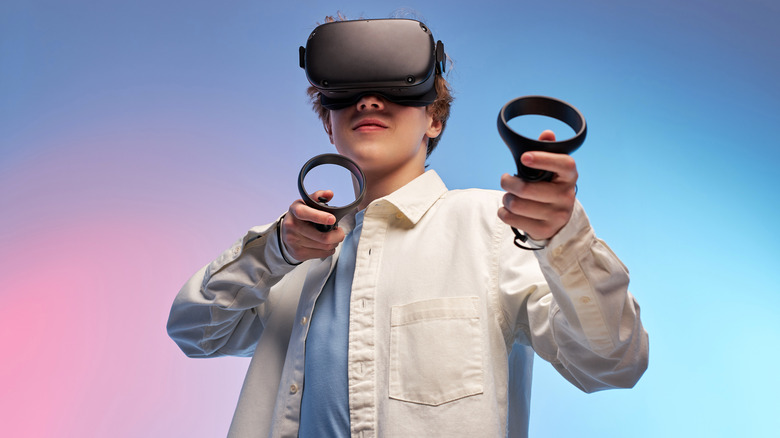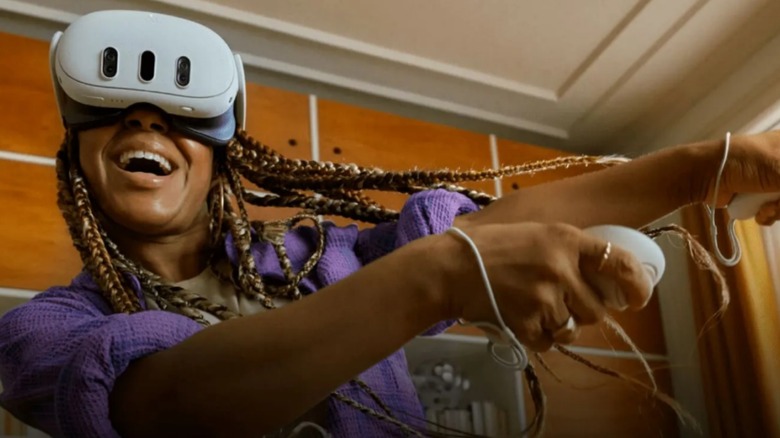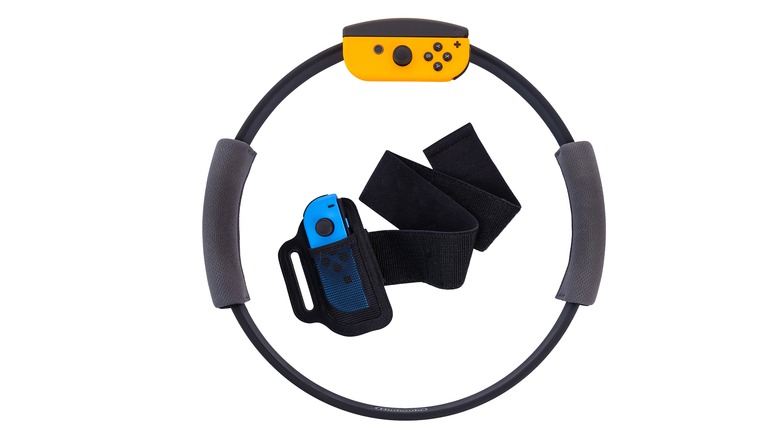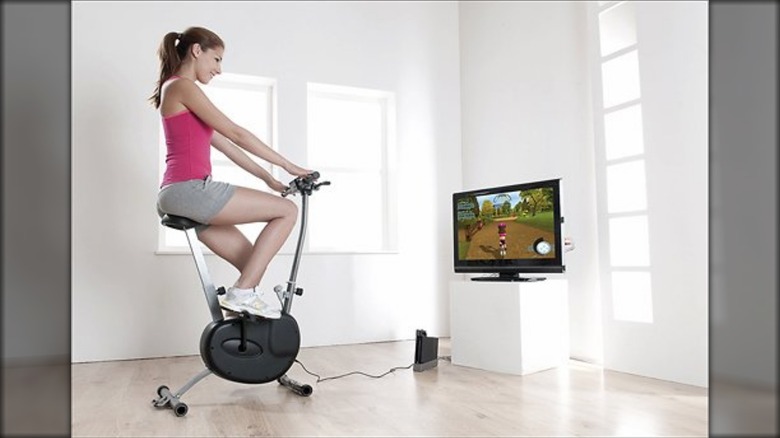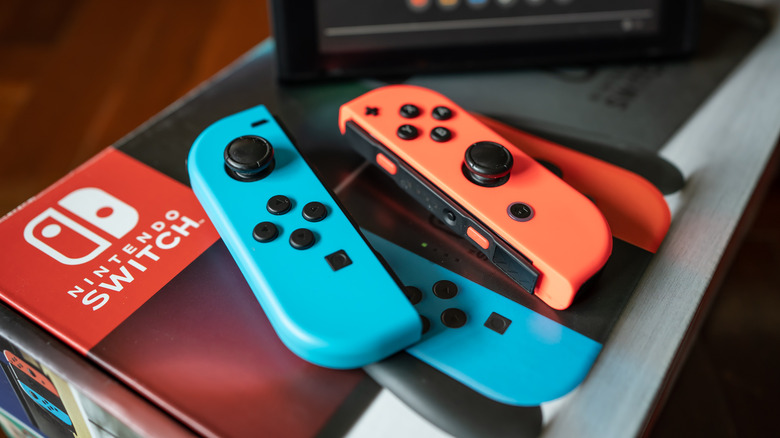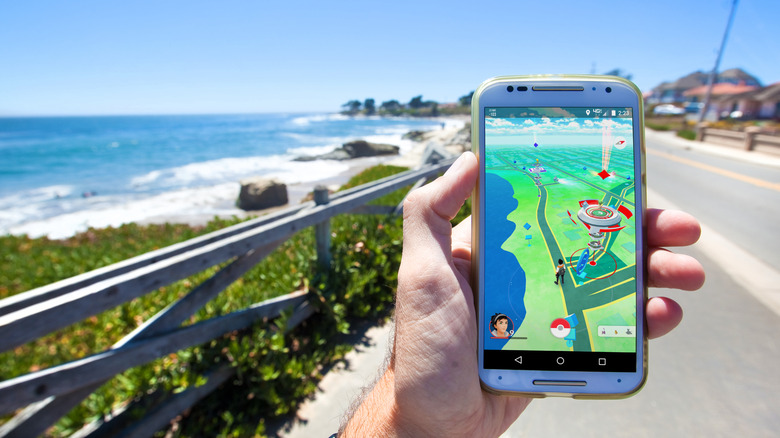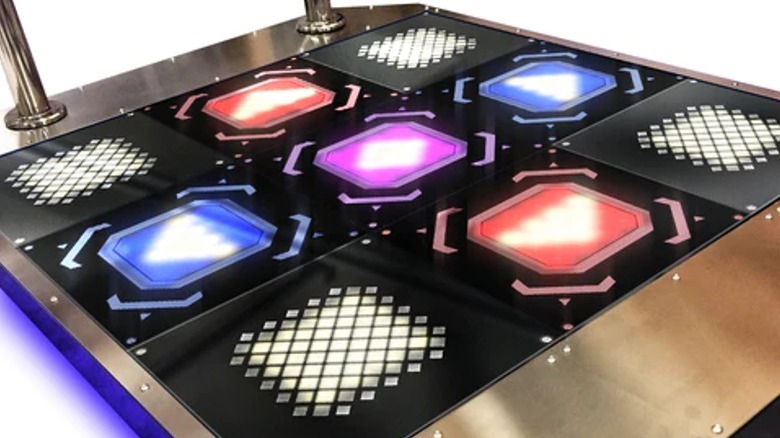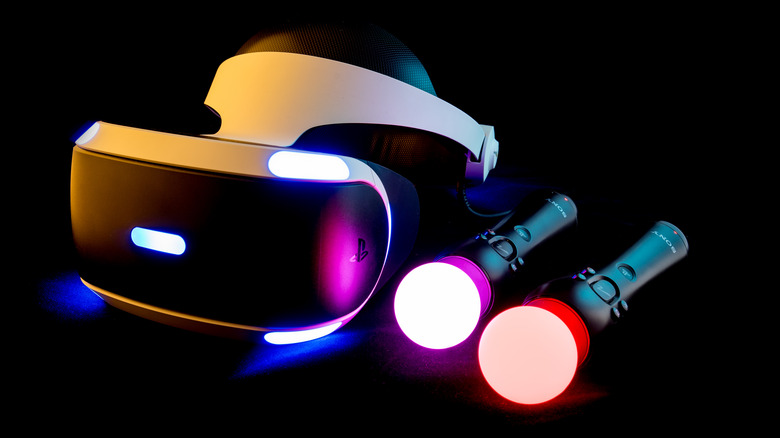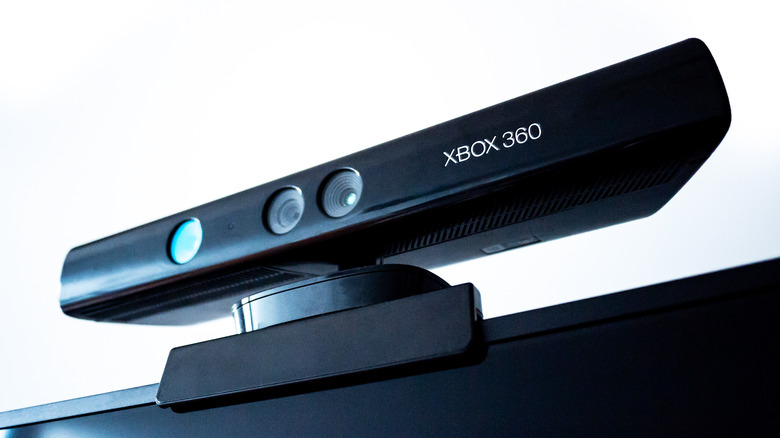8 Gaming Peripherals You Can Use To Get Fit
We may receive a commission on purchases made from links.
Exercising isn't easy, and we don't mean in the obvious way. Merely working up the courage to start or seeing your reps through is a workout in and of itself. Many people require a push when it comes to fitness, and some video games can help.
Gamification is the practice of motivating people through video games and video game designs. More and more companies are adopting gamification to help onboard new employees –- instead of memorizing instruction manuals, staff take virtual quizzes. Likewise, some organizations are gamifying exercise routines and machines to promote regular fitness. Depending on what gyms you visit, you might have even seen special exercise bikes, such as the Expresso HD, which have built-in screens and mini-games. While these stationary bikes are far too expensive for most people, plenty of video game consoles can provide a similar workout experience.
Here are several video games and their peripherals that can help you work up a sweat — no gym membership necessary.
Meta Quest 3
Virtual reality games provide an unprecedented level of immersion. Every time a player moves their head, the camera follows, and as users swing their arms, their in-game avatars reflect those actions. If you move enough in a VR game, you could get a decent workout, and many developers have realized that.
While the market is flush with VR headsets, the Meta Quest 3 is among the best you can buy because of its standalone nature. You don't need a powerful computer to use the system, which makes the Meta Quest 3 fairly wallet-friendly. Plus, no PC means no wires, which lets you exercise with abandon and not have to worry about getting tangled -– of course, you will still have to worry about bumping into walls and furniture, though. These features make the Meta Quest 3 ideal for games such as "Beat Saber" and "Pistol Whip," which are very active titles that force players to stay moving. In addition, Meta Quest 3 is also home to the dedicated fitness app "Supernatural."
If you aren't interested in a Meta Quest 3 but are still curious about VR, there are plenty of other headsets that can provide a gamified exercise experience. The PlayStation VR 2 is another example, as many games that get users moving, such as "Beat Saber" and " Creed: Rise to Glory," are available on the system. Plus, PSVR2 is also home to its own collection of exclusive exercise apps. While you can't really use VR games for strength training, they can serve as decent stamina and aerobic exercise tools.
Ring Fit
Nintendo first tried its hand at a dedicated fitness peripheral with the Wii Balance Board, although that was more designed for yoga and balance-improving regimens than strenuous exercise. Nintendo's next attempt was much more successful.
Nintendo's "Ring Fit Adventure" is a charming video game that takes players through different exercise routines, from jogging in place to tricep kickbacks. The secret to the game is its titular (and patented) ring, which connects to one Joy-Con and functions in much the same way as resistance band training. However, the ring has the added advantage of providing resistance when you pull and push on it, instead of just pulling. The other Joy-Con, meanwhile, slips into a band that attaches to the user's leg.
"Ring Fit Adventure" is a deceptively effective program. The game features colorful graphics, a variety of activities along with numerous different enemies, and RPG systems that reward players with a steady drip-feed of encouragement. YouTuber Austin John asked several professional trainers their thoughts on the game, and they felt that "Ring Fit Adventure" is a great way to get active and sweating — although if you want help regarding nutrition, you need to look elsewhere.
Still, even though the proprietary ring and leg band of "Ring Fit Adventure" aren't compatible with any other games (so far), they are well worth the investment given the exercise they provide.
Wii Cyberbike
Most exercise bikes that gamify the experience are prohibitively expensive, mostly because they have screens built into them. Some manufacturers have built more affordable versions, one of which was a plug-and-play device. All you need to do is hook it up to a Wii and start playing.
The Wii Cyberbike, as its name suggests, was an exercise bike developed for the Wii. The Cyberbike had all the bells and whistles of a regular stationary bike along with Nintendo Gamecube-style buttons that were connected to the Wii's Gamecube ports. While gamers could use the Cyberbike like a normal Gamecube controller, why would they when they could use it to exercise like a normal bike? According to a review from Gaming.fit, the Cyberbike gave workouts on par with your average elliptical, but with feedback and a variety of minigames. The Wii Cyberbikeisn't widely available anymore, but you may find one on eBay.
The Cyberbike was a unique gaming peripheral, although there are other gamified ellipticals that have more in common with the Expresso HD. Axtion's Capti Smart Bike, for instance, has a built-in screen and a game powered by the Unreal Engine that takes players on virtual adventures. As they cycle, the game encourages players to keep pedaling. The Capti even has a dragon collecting minigame similar to the Expresso HD. However, some exercise bikes are more like the Peloton Bike, which has a screen that lets users stream classes or watch their favorite shows while they exercise.
Switch Joy Cons
The ring from Nintendo's "Ring Fit Adventure" is an excellent tool to help people looking to get fit, but you don't need it to work out if you don't mind a bit of shadow boxing. Like the Wii Remote, the Nintendo Switch's Joy-Cons come standard with accelerometers and gyroscopes that permit motion controls. Many people could make a fist and barely realize the Joy-Con was nestled in between their fingers, which is why some Switch games let people exercise using their fists.
Aside from "Ring Fit Adventure," the Switch has two notable exercise-oriented games: "Fitness Boxing: Fist of the North Star" and "Fitness Boxing 2: Rhythm and Exercise." Both titles provide the same basic experience. Players are instructed to pull off specific punches to the beat, and the game judges them on their performance. Users on Reddit report that these games help them burn calories and work up a sweat, but mechanically, little sets the two apart. If you're in the mood for some boxing on the Switch, you need to ask yourself: Would you rather punch to the beat of "Sandstorm" by Darude or "Ai o Torimodose!!" from the "Fist of the North Star" anime?
iPhones and Android smartphones
iPhones and Android smartphones have been able to act as perfectly good video game consoles and peripherals for quite a while. Admittedly, most games for these devices are pay-to-win gacha money sinks and lazy asset flips, but some iPhone and Android games are actually good. Some even help you exercise.
While iPhones and Androids don't have all the capabilities of a pedometer, they can still track how far and fast their users have traveled. This technology is the cornerstone of apps such as the wildly popular "Pokémon GO," as well as titles such as "Monster Hunter Now," and "Zombies, Run!," which use gamification to encourage and to get players moving. Want to hatch an egg that might contain a Larvesta or Frigibax? Take several hikes until you have traveled a total of 10km. Looking for the materials to complete your Rathalos armor set? Walk around a park or two until you find a Rathalos. Are zombies closing in? Pick up the pace so you don't get eaten.
Not all phone exercise apps revolve around strolling around town. Modern "Just Dance" titles rely on phone apps that track your movements. For instance, "Just Dance Now," is a standalone game that records your movements using your smart device's built-in motion sensors. The other, "Just Dance Controller," pairs with whatever console you own that has a copy of the game. Both programs allow people to work up a sweat by swinging their arms in the air like they just don't care, but for the latter, let's hope the sweat doesn't make your phone fly out of your hand. That might affect your score.
Dance Dance Revolution pads
"Dance Dance Revolution," better known as "DDR," is probably the most iconic rhythm game of all time. "DDR" machines still dominate many arcades, and it's not difficult to see why.
If for some reason you missed out on the "DDR" craze that is still going strong, the game is a simple yet engrossing experience. Arrows fly across a screen, and players have to stomp on the corresponding arrows on an attached pad or platform. The more arrows they hit to the rhythm, the higher their score. Of course, this is easier said than done as the number of arrows and their speeds vary from song to song. Dance for long enough and at sufficient speeds, and you'll work up a sweat, especially if you try to hit as many arrows as possible.
While you can generally find "DDR" machines at your local arcade, many people recognize the advantage of owning a cabinet or a console port. In the early 2000s, some schools even gave students the option to play "DDR" as part of their physical education regimens, and you can still buy "DDR" machines of your own — sort of. Potential users can purchase "DDR" pads from outlets like Amazon, but these devices are useless without a PlayStation 2 and a copy of the game.
PlayStation Move Controller
After the Nintendo Wii proved a smash hit among gamers, Sony wanted part of that motion control-flavored pie. That company's contribution to the market was the PlayStation Move, which was nowhere near as successful as the Nintendo Wii. However, PlayStation Move controllers lasted long enough to receive some decent fitness games.
Unlike the Wii Remote, PlayStation Move controllers were sold separately, and in order to use them, gamers also had to purchase either a PlayStation Camera or a PlayStation VR headset -– which also required the camera. Each Move controller used both accelerometers and light-emitting diodes to track movement, which were translated on-screen. These peripherals were good for certain FPS and artsy games, and they also excelled when it came to fitness.
Many popular fitness games such as "Just Dance" and "Sprint Vector" made it to PlayStation consoles and used the Move controller. Controls were more or less identical to VR titles. Anyone who wanted to get their heart racing just had to move around with the Move controller in tow, while the PlayStation camera and the game would do the rest. Some fitness-oriented titles, such as "The Fight: Lights Out," were exclusive to PlayStation Move, but they were few and far between. Still, anyone who already owned a PlayStation Move and wanted to get a workout had plenty of quality gamified exercise regimens to choose from.
Kinect
Unfortunately, the Kinect never really took off. Microsoft discontinued all support in 2018 because the camera didn't have quite the motion tracking or fun factor it was supposed to, and its high price didn't help. Most Xbox games that were supposed to support the Kinect didn't function as intended, but a few worked relatively well with the Kinect. At the very least, they provided a decent workout.
Unlike other camera-based peripherals, Microsoft's Kinect was just a camera. This meant that the device didn't need a controller. Instead, it made the user the controller. However, that design didn't go according to plan since many games asked for movements the Kinect couldn't properly process. Unfortunately, the Kinect had fewer issues with larger movements, usually the kinds associated with exercise. However, it had more success with fitness games that revolved around dance, such as titles like "Just Dance 3" and "Dance Central 3."
Another Kinect game that could provide exercise was "Kinect Star Wars." At first glance, this minigame collection might not seem like it could get players' hearts pumping, at least until people booted up "Galactic Dance Off." This minigame was a "Just Dance 3" clone with "Star Wars" characters and parodies of popular songs with "Star Wars" lyrics. All Kinect exercise games were bound to get players off the couch and bouncing around, but only "Kinect Star Wars" could do that while also showing disco-dancing Stormtroopers.
